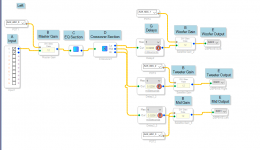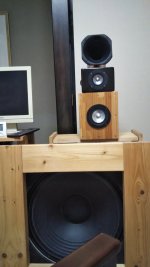Greetings-
Sorry if this is the wrong location-
Im looking to do a massive undertaking for my theater. All my speakers are going to be 3way full range speakers that actually extend to 15hz. The problem im having is finding a proper DSP/XO system. Why active, well the Woofer is a famous cheap build VBSS- it will use the same tune which XO at 250 hz where ill cross to a midwoofer. I looked in to Dayton DSP-408, but its limited and wont full apply the tune I need. And I really suck at passive XO- I cant for the life of me get anything decent ever, I have $500+ in xo parts im trying to unload lol.
The only reasonably priced DSP I found was the Dayton Audio DSPB-K DSP Kernel Board and DSPB-KE Kernel DSP Expansion 2-In 3-Out- PERFECT- I can use the .1 as intended.
Im new to this- and the cost makes it impossible to ignore. They do provide a "basic" project, but im wondering if others have used it with success, if its a viable option etc.
Plan is to use 15hz vbss tune like normal- that XO to a 12" PA midwoofer and thatll xo to a CD. Then use REW to make sure drivers are all behaving and then correct a bit to make it flatter. Ill also have my AVR's ability to dsp which uses Audyssey XT32 so realistically I can add some DSP in board and some via avr to try and not over load the boards.
All the PA460 will have a dedicated amp channel via one my FP clones- and then I have a 12 channel 30w per channel amp and a 6 channel 60w per channel amp for CDS and Midwoofers which should be more then ample seeing as the midwoofer will be xo around 250+HZ
Sorry if this is the wrong location-
Im looking to do a massive undertaking for my theater. All my speakers are going to be 3way full range speakers that actually extend to 15hz. The problem im having is finding a proper DSP/XO system. Why active, well the Woofer is a famous cheap build VBSS- it will use the same tune which XO at 250 hz where ill cross to a midwoofer. I looked in to Dayton DSP-408, but its limited and wont full apply the tune I need. And I really suck at passive XO- I cant for the life of me get anything decent ever, I have $500+ in xo parts im trying to unload lol.
The only reasonably priced DSP I found was the Dayton Audio DSPB-K DSP Kernel Board and DSPB-KE Kernel DSP Expansion 2-In 3-Out- PERFECT- I can use the .1 as intended.
Im new to this- and the cost makes it impossible to ignore. They do provide a "basic" project, but im wondering if others have used it with success, if its a viable option etc.
Plan is to use 15hz vbss tune like normal- that XO to a 12" PA midwoofer and thatll xo to a CD. Then use REW to make sure drivers are all behaving and then correct a bit to make it flatter. Ill also have my AVR's ability to dsp which uses Audyssey XT32 so realistically I can add some DSP in board and some via avr to try and not over load the boards.
All the PA460 will have a dedicated amp channel via one my FP clones- and then I have a 12 channel 30w per channel amp and a 6 channel 60w per channel amp for CDS and Midwoofers which should be more then ample seeing as the midwoofer will be xo around 250+HZ
Can you state and explain a bit simpler what drivers or finished speakers you have? All I understand is you are not sure where to find a cheap and worthy dsp crossover electronics.
Several years ago I went to an active system. Lacking huge amounts of money and any technical skills, I settled for an off the shelf solution. Of course prices and model # have probably changed, but my system would have been well < $1000 ca. 2015.
1. Win 10 PC (mine is a "TV box" costing < $200) running JRiver Media Center.
2. USB to MiniDSP USB Streamer B
3. "DAC" is a Behringer ADA8200 providing up to 8 channels
4. (Optional) "Preamp" for level matching: Behringer MX882.
Advantages: cheap, cheap, cheap. XLR audio connections = very quiet signal. The above is effectively the entire front end of an audio system, lacking only amps and speakers. It's cost (ca. 2015) was very close to $500. I've had to replace the PC a few times. But I've had zero problems with the rest. I HAVE had Behringer power amp failures (3, maybe 4 in a ~15 year period.)
Disadvantages: If your audio circle includes snobs, you have not spent sufficient money on boutique approved brands. There's a certain learning curve to set up JRMC as a multi channel crossover, but it does an excellent job. There's latency (~ 1 second) so watching videos isn't perfect. But for its main use, audio, it does everything I want.
1. Win 10 PC (mine is a "TV box" costing < $200) running JRiver Media Center.
2. USB to MiniDSP USB Streamer B
3. "DAC" is a Behringer ADA8200 providing up to 8 channels
4. (Optional) "Preamp" for level matching: Behringer MX882.
Advantages: cheap, cheap, cheap. XLR audio connections = very quiet signal. The above is effectively the entire front end of an audio system, lacking only amps and speakers. It's cost (ca. 2015) was very close to $500. I've had to replace the PC a few times. But I've had zero problems with the rest. I HAVE had Behringer power amp failures (3, maybe 4 in a ~15 year period.)
Disadvantages: If your audio circle includes snobs, you have not spent sufficient money on boutique approved brands. There's a certain learning curve to set up JRMC as a multi channel crossover, but it does an excellent job. There's latency (~ 1 second) so watching videos isn't perfect. But for its main use, audio, it does everything I want.
I am not a fan of complex crossover designs, I want to save expensive network components,
and I want to be able to easily change crossover frequencies, cut and try.
In a worm motif called,
I made a speaker that divides channels by software DSP and drives a 3-way speaker by multi-amp.
It's cost totally almost $1,500.
The speaker unit configuration is
15" CLASSIC PRO CPW15v2 for Low on open baffle
MarkAudio 5" full range Alpair5v3 for Mid
JBL.Selenium D220Ti + JBL.SELENIUM HL14-25 for High
The equipment used was
Hardware is a PC LENOVO ThinkCentre M93 Tiny Core i3
Software is player software running on windows 10: DSP software part of FrieveAudio.
FrieveAudio has 8ch DSP.
And Steinberg 8CH.DAC, Dayton Audio microphone EMM-6 for measurements.
For the multi-amplifier I initially use YAMAHA 7.1CH.AV amplifier.
The procedure is
1. Place the microphone at the listening position
Measure LOW/Mid/High frequency response of left and right.
2. Correct the frequency response of each band to flat by REW of DSP.
3. Set the cross over frequency and roll-off of each band by DSP.
Tentatively, set 300Hz/800Hz and roll-off 48dB/oct.
4. listening to a monaural sound file and adjusting the level of each band.
Adjust the level of each band and the cross frequency of each band while listening to a monaural recorded sound file.
5. Repeat the cut-and-try procedure described above while listening to many sound sources.
The focus of the listening adjustment is to obtain the phantom center and achieve a clear phantom sound image.
As a result, the vocals sound as if they are sung right in front of me at the appropriate size,
Each instrument is heard clearly in perspective, left and right.
Supplementation,
1.The player software can be replaced with foober2000 and VST.
2.Because of the high efficiency of the high-frequency unit,
I was concerned about the noise of the drive amplifier AV amplifier that drives the high frequency unit.
I switched to the noiseless headphone amp, the Fostex HP-A7.
3.Low unit covers 30Hz and above.
4.The size of the room is 3.6mx3.6m, which is average in Japan.
5.I listen only file sours.
and I want to be able to easily change crossover frequencies, cut and try.
In a worm motif called,
I made a speaker that divides channels by software DSP and drives a 3-way speaker by multi-amp.
It's cost totally almost $1,500.
The speaker unit configuration is
15" CLASSIC PRO CPW15v2 for Low on open baffle
MarkAudio 5" full range Alpair5v3 for Mid
JBL.Selenium D220Ti + JBL.SELENIUM HL14-25 for High
The equipment used was
Hardware is a PC LENOVO ThinkCentre M93 Tiny Core i3
Software is player software running on windows 10: DSP software part of FrieveAudio.
FrieveAudio has 8ch DSP.
And Steinberg 8CH.DAC, Dayton Audio microphone EMM-6 for measurements.
For the multi-amplifier I initially use YAMAHA 7.1CH.AV amplifier.
The procedure is
1. Place the microphone at the listening position
Measure LOW/Mid/High frequency response of left and right.
2. Correct the frequency response of each band to flat by REW of DSP.
3. Set the cross over frequency and roll-off of each band by DSP.
Tentatively, set 300Hz/800Hz and roll-off 48dB/oct.
4. listening to a monaural sound file and adjusting the level of each band.
Adjust the level of each band and the cross frequency of each band while listening to a monaural recorded sound file.
5. Repeat the cut-and-try procedure described above while listening to many sound sources.
The focus of the listening adjustment is to obtain the phantom center and achieve a clear phantom sound image.
As a result, the vocals sound as if they are sung right in front of me at the appropriate size,
Each instrument is heard clearly in perspective, left and right.
Supplementation,
1.The player software can be replaced with foober2000 and VST.
2.Because of the high efficiency of the high-frequency unit,
I was concerned about the noise of the drive amplifier AV amplifier that drives the high frequency unit.
I switched to the noiseless headphone amp, the Fostex HP-A7.
3.Low unit covers 30Hz and above.
4.The size of the room is 3.6mx3.6m, which is average in Japan.
5.I listen only file sours.
Attachments
Last edited by a moderator:
- Home
- Loudspeakers
- Multi-Way
- Digital 3way Crossover Sigma Studio?

